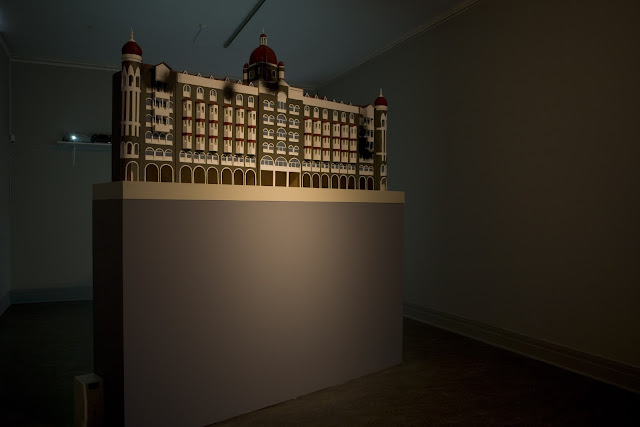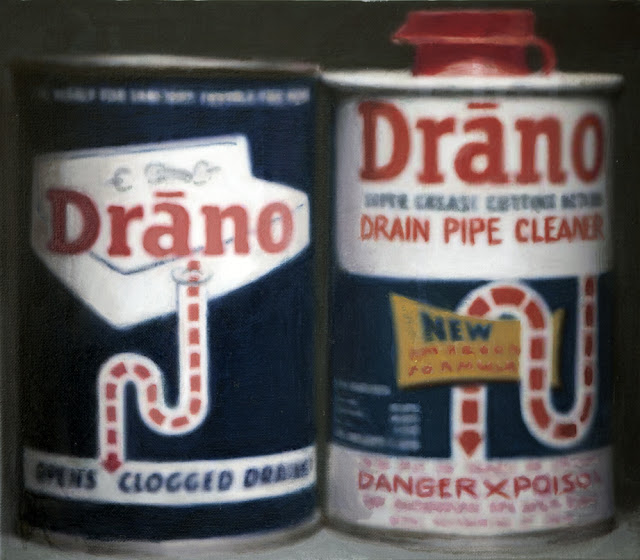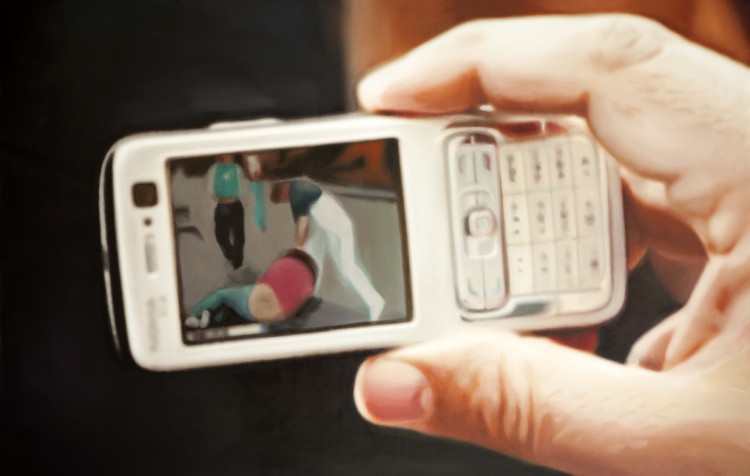Attention!
By nielsbonde, 7th March 2009
Anmeldelse af Camilla Jalving:
https://www.kristeligt-dagblad.dk/kultur/se-mig
Interview with curator Lone Schubert at Horsens Art Museum
In the exhibition ”Attention!” you are exploring the quest for fame and fame as an end in itself – an end that justifies any means – and about mass medias role in this. Can you elaborate on that?
Yes, the lust for attention is the topic for this exhibition. Since the late 80’s I have seen how new media and – at that time – fringe technologies like the internet has become mainstream. In the early 90’s tech lovers talked about how the anarchistic internet should liberate us all. It should be a part of a democratic process, where everyones shared acces to information should spearhead freedom (”Information want to be free”).
There were a lot of utopian ideas and revolutionary innovations, many of which have been so overwhelmingly successful that they have become the basis of how people behave, interact and relate to things in their daily lives. Most people now would now rather be without sex for weeks than being without their mobile phone, and surprisingly an electronic gadget have edged its way far up Maslow’s Hierachy of Needs. Today you would first leave home and then make your appointments as you go along – not vice versa.
In the same way the internet has changed the way we relate to information both as text and images – for better and for worse. You can use the net in many ways, and part of it is absolutely fantastic, there’s absolutely no doubt. Moreover it does not matter what you and I are thinking about it, for it is here to stay, so we have to learn to deal with it. All of a sudden we can exchange pictures in a completely different way than previously. Before the camera was invented, well over 180 years ago, the actual production of images depended on of how good your drawing, painting or sculpting skills were. After Daguerre, even the poor draughtsmen could get a decent picture, but the cameras were scarce and the images had to be copied by hand and transported by land. But since the net and cell phone cameras one can publish any image instantly and once they have been published, they will be shared . This is the new thing: people are beginning to produce images with the intention that they are to be exchanged.
Yes, you get a certain status by having just the right picture and by being in the picture. It is interesting that if we allow ourselves to ignore whether the picture is good or bad, but just look at how it is being used – it’s interesting that the image is used as a form of currency in a battle for more attention. It is interesting how the image has this new role, it is not just something you take at face value, it has lost its naivity.
If the images can be regarded as currency, so one might say that there are big differences in their value – for the exhibition, you choose a very specific type of images, which primarily deals with either violence or sex …
Yes, the exhibition is about “how currency is generated .” In general the pattern is that the boys generate extra image value through happy slapping and violence, and the girls, like Paris Hilton, through peddling their vagina. In 2008 a danish teenager – Rasmus Popenda – beat a random man to death. As the man lay dying, Popenda whips out his cell phone to make a video, but drags the dying man 20 meters to a street lamp to get better lighting. The video was directly posted on YouTube, and Popenda was subsequently arrested about an hour after the deed. Then there are the terrorists who make “martyr videos” as a kind of pop videos with background music, graphics and editing – all made in an aesthetic form – it’s aesthetized violence.
You say that the case is less important than the aesthetic?
In the videos, the cases are certainly not argued. In the actions, they rarely even try to make their case. All teens have a desire to be special, and when they perceive they do not have that many options, they seize them where they can. Today it is possible for everyone to become a celebrity – at least for a short period.
Of course, it’s not just negative, but a development that changes anything – not just with small steps – but with tiger leaps. Now we see pictures from the actual torture and get a much more horrendous specific knowledge – now the pictures are evidence, in a world where everything photographed eventually becomes public. When we for example consider the murderer from Aalborg, the guy with the cell phone camera, he appears as a uniquely callous and brutal, but he is not the first of that kind in world history and will not be the last. As a child I read the Icelandic sagas and in one of them, I think it was Egil’s Saga, Egil as a child comes riding and see a peasant working on the fields. As Egil by the spur of the moment chops the head off the completely random peasant, he is then demanded an explanation. “Because he was standing perfectly for a beheading”. But one thing is to have something like that recounted, another thing is to get very specific photo documentation of it.
Of course, it’s not just negative, but a development that changes anything – not just with small steps – but with tiger leaps. Now we see pictures from the actual torture and get a much more horrendous specific knowledge – now the pictures are evidence, in a world where everything photographed eventually becomes public. When we for example consider the murderer from Aalborg, the guy with the cell phone camera, he appears as a uniquely callous and brutal, but he is not the first of that kind in world history and will not be the last. As a child I read the Icelandic sagas and in one of them, I think it was Egil’s Saga, Egil as a child comes riding and see a peasant working on the fields. As Egil by the spur of the moment chops the head off the completely random peasant, he is then demanded an explanation. “Because he was standing perfectly for a beheading”.
But one thing is to have something like that recounted, another thing is to get very specific photo documentation of it.
Some of the paintings and drawings are part of installations, but yes, I have made a model of Mumbai’s opulent Hotel Taj Mahal for a video installation, about the Pakistani terrorists in the Mumbai attacks 2008 shot indiscriminately in the crowds and killed altogether 154 people. It was a martyr / suicide operation, but it is unclear what they were trying to achieve. The terrorists also attacked Victoria Station where they shot a lot of ordinary people, and proceeded to attack a hospital for poor women with children. All this, was to draw attention to what? In such terrorist attacks, one would have believed that there was some specific point to it, but it seems to be absent in the argument sequence, which becomes remarkably hollow and pointless. In the installation you see, projected on the model of Hotel Taj Mahal, an enacted video of the surviving terrorist recounting his story from his falling out with his parents, over his recruitment and training to the final terrorist act, which was aimed at the ultimate goal: to get in the media. The text in the video is taken from his confession reprinted in Indian news.
Some of the paintings and drawings are part of installations, but yes, I have made a model of Mumbai’s opulent Hotel Taj Mahal for a video installation, about the Pakistani terrorists in the Mumbai attacks 2008 shot indiscriminately in the crowds and killed altogether 154 people. It was a martyr / suicide operation, but it is unclear what they were trying to achieve. The terrorists also attacked Victoria Station where they shot a lot of ordinary people, and proceeded to attack a hospital for poor women with children. All this, was to draw attention to what? In such terrorist attacks, one would have believed that there was some specific point to it, but it seems to be absent in the argument sequence, which becomes remarkably hollow and pointless. In the installation you see, projected on the model of Hotel Taj Mahal, an enacted video of the surviving terrorist recounting his story from his falling out with his parents, over his recruitment and training to the final terrorist act, which was aimed at the ultimate goal: to get in the media. The text in the video is taken from his confession reprinted in Indian news.


But we give the images value by looking at them – you attach value to them by turning them into paintings and include them in an exhibition, researchers address them as phenomena and one politician used Paris Hilton in his election campaign – so we are many who are helping to ascribe meaning to the empty shell …
Yes, and that the thing about humans, we are social creatures – just like flies, 1 million flies can not be wrong: shit really is good! If someone attaches value to an action, it is a plus, if there are more followers, the importance increases, and if there is a crowd of fans, then whatever it is it must be great! Of course I am also part of this system. However, we can ask ourselves the question: which parts of these mechanisms could perhaps be taken apart and analyzed. I don’t presume I will change any of these mechanisms by doing an art exhibition – but talking about it can never be wrong, it might change at the inner side of some people’s heads.
You’ve chosen some images or episodes that seems to be devoid of content – there is no clear case or clear goal – it is not freedom fighters, fighting for a noble cause, but terrorists who seems very concerned about their appearance on images be it surveillance footage or their own pictures. Like the young man who went berserk at Virginia Tech, because he felt aggrieved and wanted to share it with the world – it seems as if you choose the stories where the cause is absent …

Yes, I have chosen case stories which are extreme – Cho Seung-Hui at Virginia Tech interrupts his murdering rampage because he needs to go back to his dorm and complete his ”media package” which he subsequently sends to NBC, where he complains that he has been wronged in some way and that people have not appreciated him enough. Cho feels that he has not received enough attention, and the attention he has received has not been right, and believes he has the right to kill to get his kind of attention – kill, not specific people but “people” in general. Mass media, internet and the now ubiquitous (surveillance) cameras are used for shameless self-promotion and to disseminate information. If you can’t achieve “15 minutes of fame”, at least you get “15 minutes of shame”. Paris Hilton is much more sympathetic in her methods, but she is no less banal. The means are gender specific, the girls use sex and boys use violence.
This does of course not have comparable consequences …
Paris Hilton: She probably annoys many – but she kills none. Surely the view on women as such may be harmed, and all the little girls who may think she is a role model, are being harmed a little each but not more than that it should be possible to counteract. Death is so much more definitive than even the worst attitude.
One can only hope that the attention that the images and people get, result in a heightened awareness about how empty this attention is. That the images that are a result of this are freely available, challenges us to develop a self-discipline and take responsibility when it comes to rearing our children so they learn to navigate in media and interpret these images.
The last 15 years’ technical advances in the image making and -distribution have made it necessary to consider images in a different way, in a new way. I am well aware that every generation since Plato, has believed that precisely their generation have been subjected to completely new terms, brand new unheard-of opportunities that change the world. Nevertheless each generation still have to consider how it relates to the challenges – eg. in connection with the awful images of torture at the Abu Ghraib prison – I have no doubt that torture has always existed – but now we suddenly have pictures of it, images that not only degrades the people subjected to the torture, but also those who perform it – and those who witness it. Images are everywhere because of digital cameras, and because images can be shared over the Internet. All of a sudden it’s not just one picture in a single person’s hand. Now it’s something that can be disseminated and shared in the same way as words, but they carry much more weight. This is where the new aspect comes into play with regards to the usage of images as well as it forces us to react to the actions in front of the camera.
But here it is a tool in the democratization process, a positive development …
We are next to some paintings that will be included in the exhibition. These are images taken from the media, they are painted 1:1 …
Well not quite 1:1. In the process before I start to paint the pictures, there is always an editing process, but almost 1:1. It can be seen as a last step in a long process, the first part: a photographer takes a batch of pictures, the next step: an editor selects the from a whole group of photographers: the chosen image is published in a magazine, on a website or whatever. There are a million different levels of choice before the images reaches the consumer (in this case: me), and the painting process is the part where I try to arrest time, making it matter exactly which image I choose – I chose this picture over another because it is more important in the context. By investing my work and my time, I am in my microcosm stopping the incessant flow where different levels of attention alternates – when the images are on the internet they become part of the flow. I am well aware that as the photographer presses the shutter, he is doing it deliberately, but in that accelerated speed, and as quickly as the images are passing our retinas via tv and net, the refresh rate is so quick that images are impossible to remember the day after. The actions behind the images loose their meaning, at the end what is important, is just becoming known and have photographers take the pictures that make that you become even more famous.
It’s an interesting point that the gravity becomes palpable, when you convert the images to the painting – perhaps that is why the effect is so fierce when faced with painted portraits of people known to have committed murder or terrorism.
I am well aware that there is a danger that it seems as if I glorify individuals and events. Therefore it is very important to me that the images not seen as single images, but that they viewed in the context, so you see the characters and their actions as phenomena, and each image is part of the story. In this way I take, as an artist, each part serious, as I toil to make each picture one by one and unravel the story, which I put together in a larger context, in an analytical approach to the events.
Now we’ve talked about some paintings, but the exhibition also includes installations?
You have chosen to call the exhibition “Attention!” One can say that it is a rather complex concept that you have addressed. Seems to me that the title refers both to some of the things we spend time on are in fact empty – the message is empty and that we should stop and think about what it is we are a part of. But it can also refer to the attention of Paris Hilton or that of the perpetrators and what they hope to obtain through pictures and actions.
I wanted to have a title that was open enough to describe a wide range of meanings, for it is very complex issues, I try to shed light on. I don’t have all the answers, the questions are so new that it’s hard to figure out the syntax. But I think it is important the questions. What are the new perspectives that our new massive use of cameras shows us? In the end 80s and early 90s, I made video installations dealing with control, hacking and surveillance and I was in a show at MIT List Visual Arts Center on the topic. At the time I was living in New York on a scholarship and at the time I saw an advertising campaign stating “Every Day You’re Being Recorded on Video 36 hour , Would not You Like To Look Your Best?”. It was an amusing take on surveillance anxiety, as well as a critical commentary. Today we surely have to multiply the number of cameras by ten, but the questions are fewer. As an artist I am interested in asking questions and exploring our use of images, then I just have to see what answers I get.







